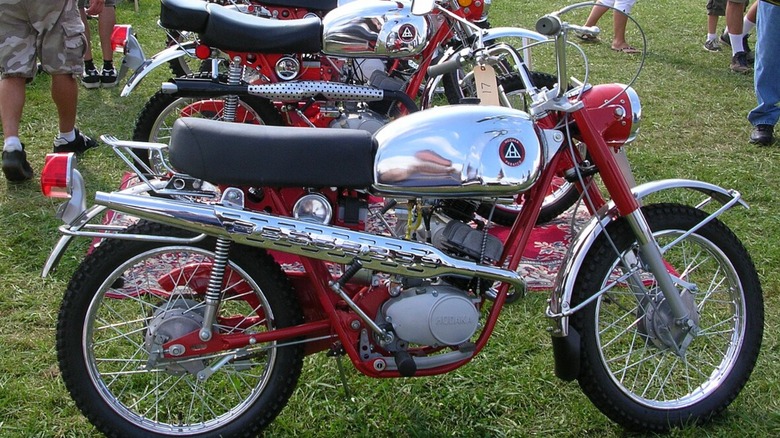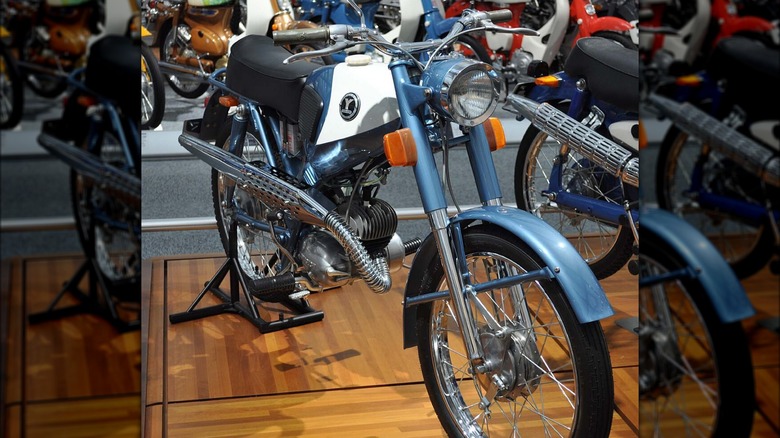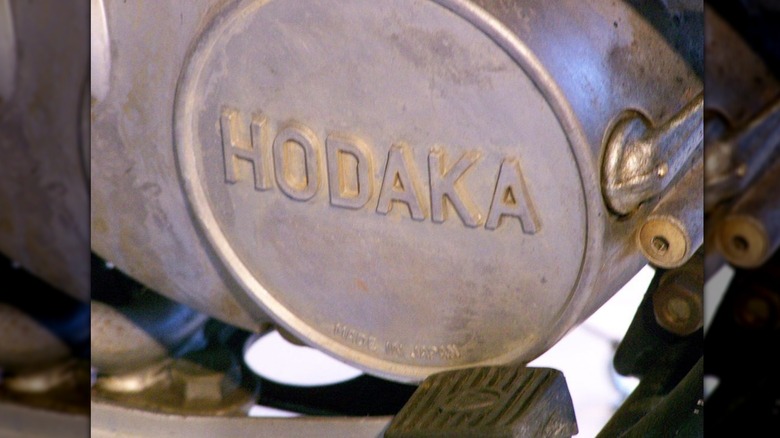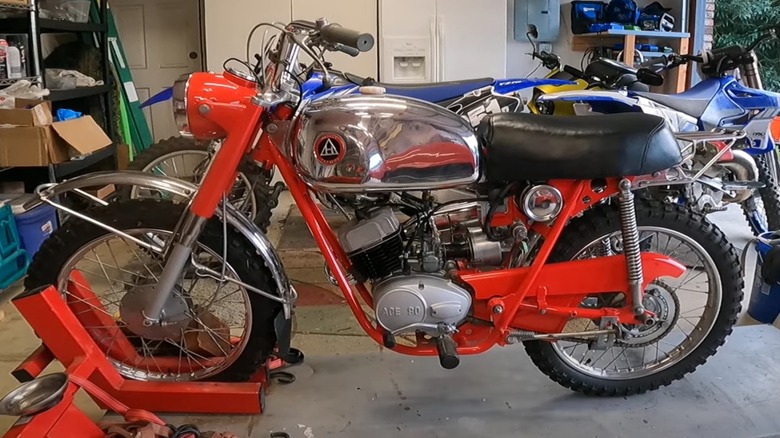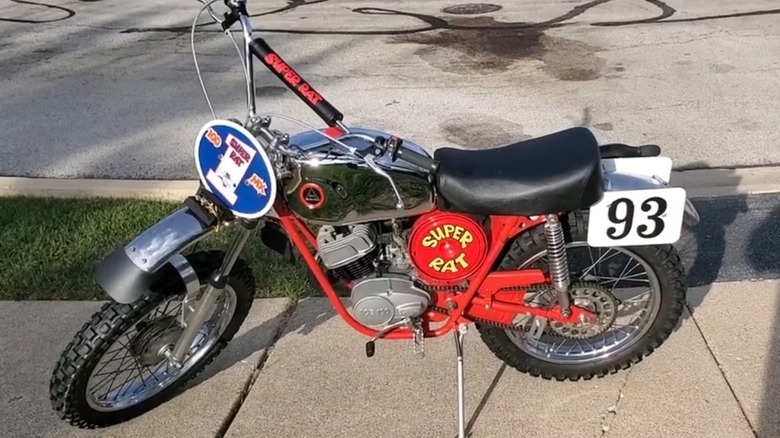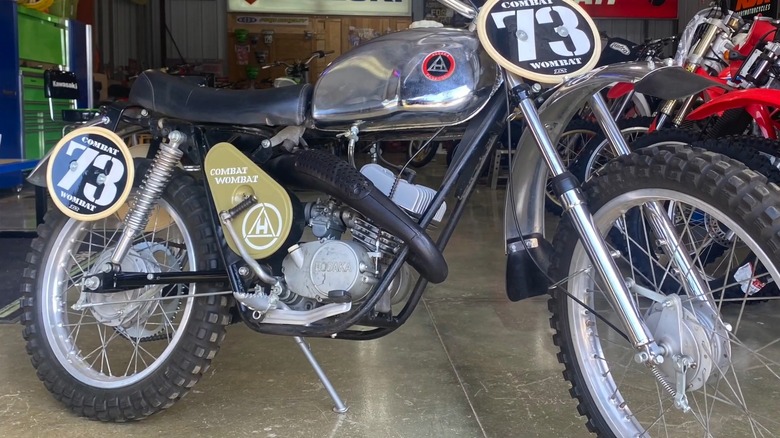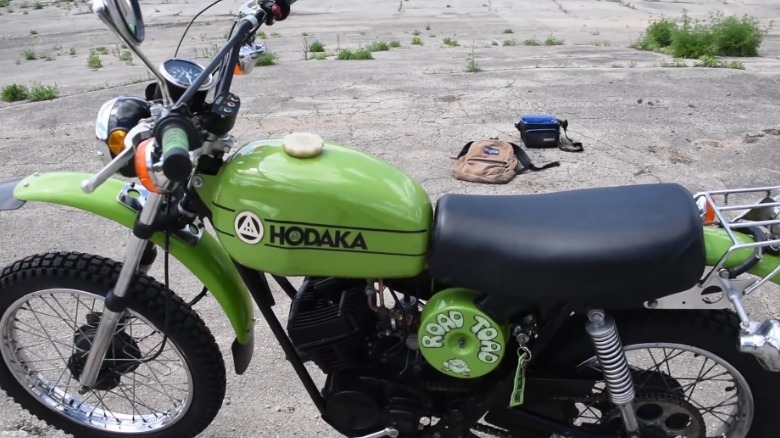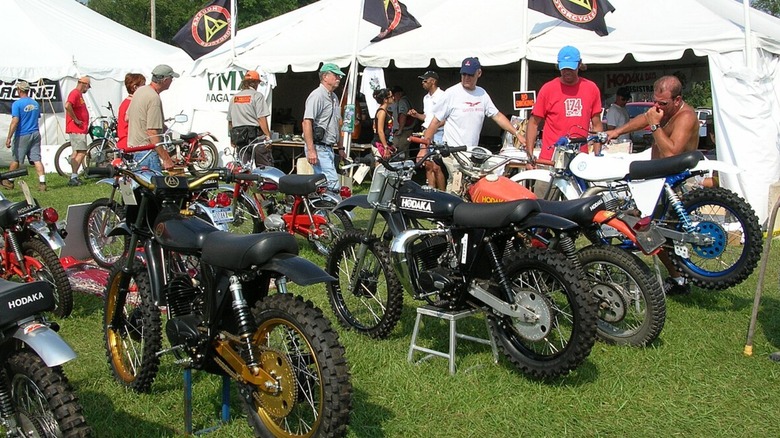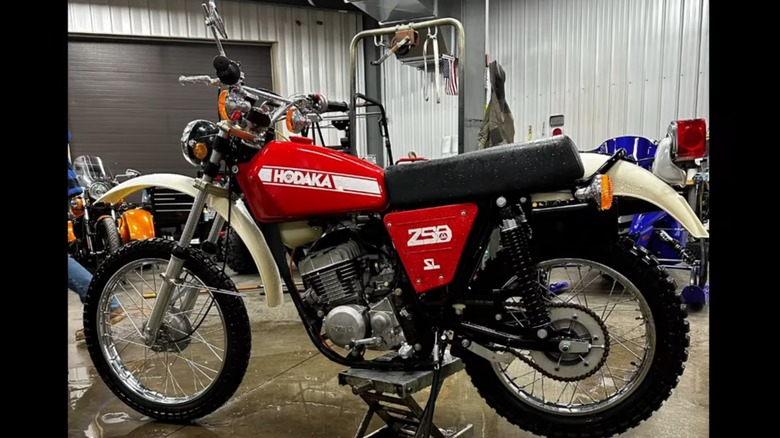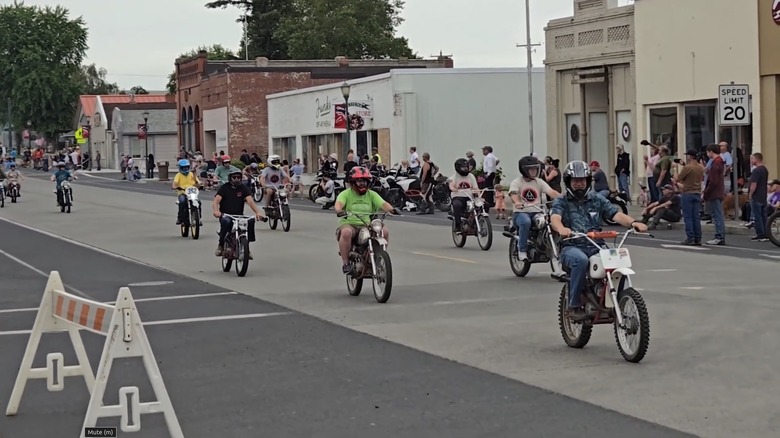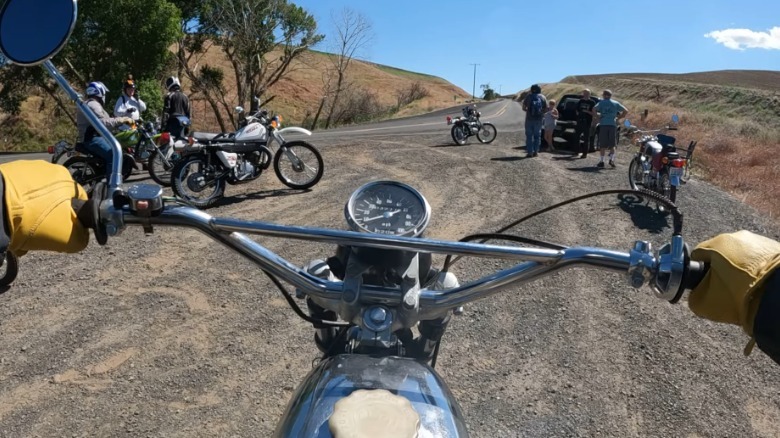The Story Of Hodaka: The Best Dirt Bike You've Never Heard Of
The 1960s were a fantastic time for dirt bikes. While people had been racing motorcycles off-road for some time, it was not until the 1950s that it made much of an appearance in the U.S. Once it gained a foothold, the sport spread with manufacturers rushing in with new products to fulfill demand. Japanese manufacturers had only just begun building and selling motorcycles here in 1960, but by 1970, they exploded with popularity while classic dirt bikes from Japanese and European makers paved the way for what we ride today.
During the early period of dirt bike production, brands popped up from all over, although not all made it until today. Greeves, Bultaco, and CZ are popular European dirt bikes out of production while one that made a name for itself back then came from the U.S. Hodaka dirt bikes were built from 1964 to 1978 by a company in Oregon with manufacturing facilities in Japan.
This article would not have been written if not for the fact that my first motorcycle was a 1973 Hodaka Super Rat that I bought for $75 when I was 13 in the late '80s. Even then, none of my friends knew anything about Hodaka and mine was always the only one on the field. Regardless, I loved it, and that's why I am going to tell you about the best dirt bike you have never heard of.
[Featured image by Jamie Aaron via Wikimedia Commons | Cropped and scaled | CC BY-SA 3.0]
Yamaguchi motorcycles
Sometime in the late '50s, Pacific Basin Trading Company was set up in Athena, Oregon distributing chemicals for Farm Chemicals, Inc. At some point, Shell petroleum bought the parent company and left it as an independent operation called PABATCO. Looking to diversify product offerings, management struck a deal with the Japanese motorcycle manufacturer Yamaguchi to distribute bikes in the U.S. Motorcycles soon became PABATCO's only concern, and Yamaguchi models began selling, even receiving a good review by Cycle World in 1962.
5,000 Yamaguchi models had been imported by 1963 and sold through PABATCO's 480 dealers. However, bankruptcy suddenly befell Yamaguchi, leaving PABATCO with nothing to sell to its dealers. This left the company in a precarious position and threatening bankruptcy. Furthermore, Yamaguchi's engine supplier, Hodaka Industrial Company, was also left without its main customer.
In a bold attempt to keep everything from going down in flames, the people behind PABATCO put together a proposal and went to Japan to work out a deal for Hodaka to build whole motorcycles to export to the United States to supply PABATCO's existing dealer network. Hodaka agreed, and the brands got to work.
[Featured image by Rikita via Wikimedia Commons | Cropped and scaled | CC BY-SA 3.0]
Hodaka motorcycle brand is born
Although the PABATCO team faced tremendous hardship, it persevered and birthed a new motorcycle brand. From the start, PABATCO manager Henry Koepke wanted a bike that could fulfill several needs while avoiding going headlong towards the competition. Using the Yamaguchi SPD Scrambler as a jumping off point, the team put together a list of features to include in the design. The company wanted a steel-tube frame, high fender clearance, adjustable folding footpegs, long-range fuel tank, a cylindrical toolbox, and chrome plating for the entirety of the fuel tank. The idea was to create a competent trail bike with broad appeal and versatile capabilities.
With PABATCO in charge of design, Hodaka ramped up production, and the former suppliers of Yamaguchi lined up with parts and materials for the new venture. In mid-1963, Koepke went to Japan to assist with getting production started, working tirelessly with his and Hodaka's team until the factory was ready to produce the first Hodaka in December 1963. By June of 1964, 759 copies of the first Hodaka made it to American soil.
The first model was the 1964 Hodaka Ace 90, a 90cc two-stroke trail bike. The turnaround from design to finished product was remarkably quick, but the resulting product proved to be well-built as it kicked off what would become a highly successful enterprise.
[Featured image by Chuck Shultz via Wikimedia Commons | Cropped and scaled | CC BY 2.0]
Hodaka Ace 90
Once PABATCO had its dealers supplied with brand new models of the Hodaka Ace 90, the bike needed to sell, and it had the right mix of features to make it a good seller. It had a sprightly 90cc 2-stroke engine coupled to a 4-speed patented constant-mesh gear engagement system sitting on a twin downtube steel frame. The gas tank came chrome plated, and the bike offered complete lighting and a speedometer for legal use on the road. While the engine only produced 8.2 horsepower from its 90cc cylinder, the frame was robust with thick shocks that could handle much more.
Shortly after its introduction, Cycle World published a review in which it heaped much praise upon the small but tough machine. Lauded for having ample power, a broad and comfortable seat, and generous ground clearance, the Hodaka obviously impressed the reviewer who found little to complain about. Things looked good for PABATCO at this point, and by 1970, it had sold more than 24,000 motorcycles.
Although it was the only model from Hodaka, PABATCO continued development and introduced a 100cc version of the Ace in 1968. This coincided with both engines being equipped with 5-speed gearboxes and a higher top end as a result. All the while, PABATCO stuck with the philosophy followed by Henry Ford with his first production car, the Model T, allowing customers to buy a Hodaka in their favorite color, so long as their favorite color is red.
Hodaka Super Rat
By 1987, Hodaka had been shuttered for 14 years. When I found a running and rideable dirt bike for $75, Hodaka's existence mattered little. Furthermore, if not for the fact my father wanted a Cushman Eagle in the '50s, I may not have had my 1973 Hodaka Super Rat a generation later.
The Super Rat was Hodaka's second model, released to accompany the Ace in 1969. It was meant to be the SR100, meaning Special Racer, but someone at PABATCO joked that it should be called the Super Rat, and it stuck, beginning a tradition of whimsically named machines. While it shared features with the Ace, the Super Rat was a larger bike, and its engine was modified and uprated in many ways for more power. It was simple and reliable, and it performed well in many races of the era, becoming the top choice in the 100cc class.
While I could never keep up with my friend on his Kawasaki KX125, a leading motocross racer at the time, it was still fun and had plenty of power for trails and mild jumps. Plus, I liked that my friends could not get used to the one up, four down gearbox pattern and never wanted to ride it. When new, the Super Rat was hailed for its performance in racing but also for being approachable and easy to ride for anyone. I have to agree, and that as a teenager's first motorcycle, the Super Rat is near perfect.
Combat Wombat, Road Toad, Dirt Squirt, and more
With the Super Rat tearing up American trails and flying out of dealer doors, Hodaka expanded. It differentiated itself with jovial names and marketing to match. From 1972 through 1975, it added the Wombat, Dirt Squirt, and Road Toad to its lineup before "growing up" and reverting to the alpha-numeric naming typical of the competition.
1972 brought the first Hodaka with a 125cc engine, the Wombat. This was a larger enduro bike displaying many changes from previous models, including a typical one down, four up gearbox pattern. However, this would soon be accompanied by a competition version cleverly labeled the Combat Wombat, which came race-ready without street-legal gear. Hodaka further refined this into the Super Combat, a top performer motocross bike that was the fastest 125 on the market for a time.
The Dirt Squirt was first a 100cc model, but later made into an 80cc to compete with other mini bikes, a segment that has seen a resurgence of popular models today. Hodaka replaced the Ace 90 with the Road Toad, featuring the 100cc engine, updated with oil injection and full road-legal equipment. When Hodaka finally released a 250cc bike in 1976, it also received the last of the clever model names, the Thunderdog 250.
The beginning of the end
By 1977, Hodaka was only producing three models, the DS80, 175SL, and 250SL. Production numbers had fallen from their peak when several individual models reached 4,000 units in a year, and the 1972 Wombat production peaked at 14,500. The following year was the year things began to unravel.
While PABATCO was an innovative company staffed with dedicated people, it was a small distributor that relied on a separate organization to build the bikes it designed. Unlike Honda or Yamaha, it had limited control over manufacturing. Furthermore, PABATCO and Hodaka relied on separate financial backers, creating other conflicts between several parties on two sides of an ocean and speaking two very different languages. PABATCO's parent company Shell attempted to solidify control of operations in 1972 by offering to purchase 50% of Hodaka, but the offer was rebuffed.
After Hodaka's peak in 1972, a confluence of factors led to increasing difficulties for PABATCO. Regardless, the company continued developing and releasing new models throughout the 1970s.
The final days of PABATCO and Hodaka
While Hodaka experienced turmoil within the organization, Honda released the CR250M Elsinore in 1973 followed by Yamaha's excellent and long-lived YZ250 in 1975, signaling a complete buy-in of the Japanese majors, which could build in volume for lower cost than Hodaka could. Dealers also began complaining about quality, which likely declined because Hodaka had failed to expand its facilities while production rose, further souring relationships throughout.
Perhaps the biggest factor pushing Hodaka under was the falling exchange rate, leading to the dollar buying about half as many yen as when PABATCO began. Disagreements emerged as Hodaka realized that production levels needed to rise to remain profitable long after PABATCO suggested it. Hodaka had also been slow to innovate and the guys in Oregon were powerless to force the issue, causing features like oil injection to come years after the competition had it. PABATCO made up for its shortcomings by overspending on marketing. By the end of 1978, PABATCO was defunct and the Hodaka motorcycle was dead.
Hodaka began supplying parts to Honda, Yamaha, and Toyota to stay afloat while looking for a new partner for motorcycle production. A prototype motorcycle emerged and a joint Taiwanese venture to build a 50cc moped picked up but failed to make it to production. In the end, Hodaka sold all of its tooling to Korean Daelim, now DNA Motors, for new motorcycles, but a partnership with Honda eliminated the need for anything else from Hodaka shortly thereafter.
Hodaka's legacy
Nearly 50 years since the last Hodaka rolled out of the factory, people continue to keep the brand alive. Starting in 1986, Strictly Hodaka set up in Vermont, supplying owners with parts and resources to keep their bikes running, taking pride in having nearly every part imaginable in stock. Hodaka Parts, Inc. began in Union, Missouri in 2018 for the same purpose and later bought Strictly Hodaka, rolling it into a single operation selling new old stock parts, reproduction parts, and used parts. With this resource, keeping a Hodaka running is as easy as any modern bike.
In addition to maintaining your Hodaka, you can join the Hodaka Club, which connects owners with events and resources and also maintains an active forum with recent posts receiving thousands of views. The club meets during its annual Hodaka Days event, occurring the last week of June in Athena, Oregon. This three-day event has been happening for years, assembling the largest grouping of Hodaka riders in the country for activities including camping, trail rides, racing, and more.
While many classic motorcycle brands aren't around anymore, few remain so loved by riders as Hodaka. I am glad I happened upon this quirky bit of motorcycle history with my first bike, but sadly, I sold it. It would be worth thousands now. Unless you've already rode or owned one, perhaps now you can see why Hodaka is the best dirt bike you'd never heard of.
